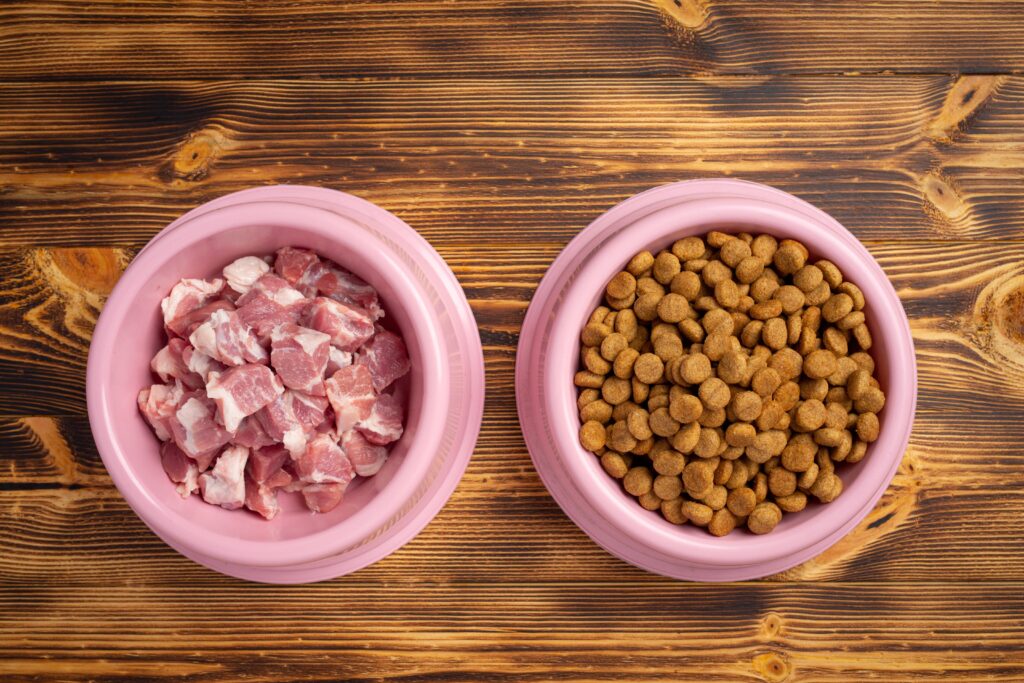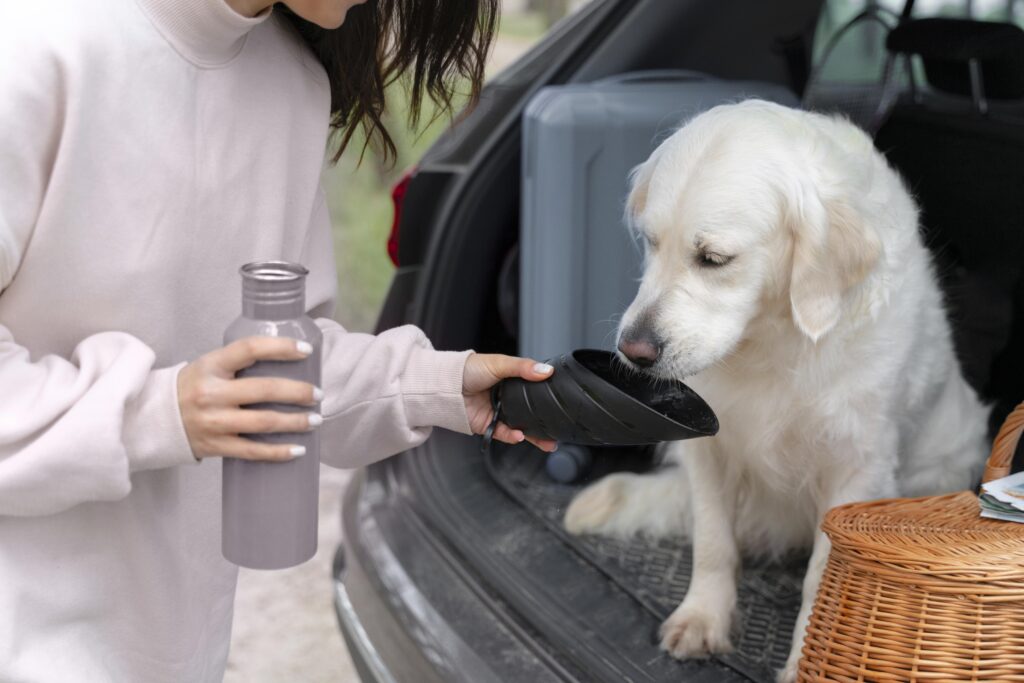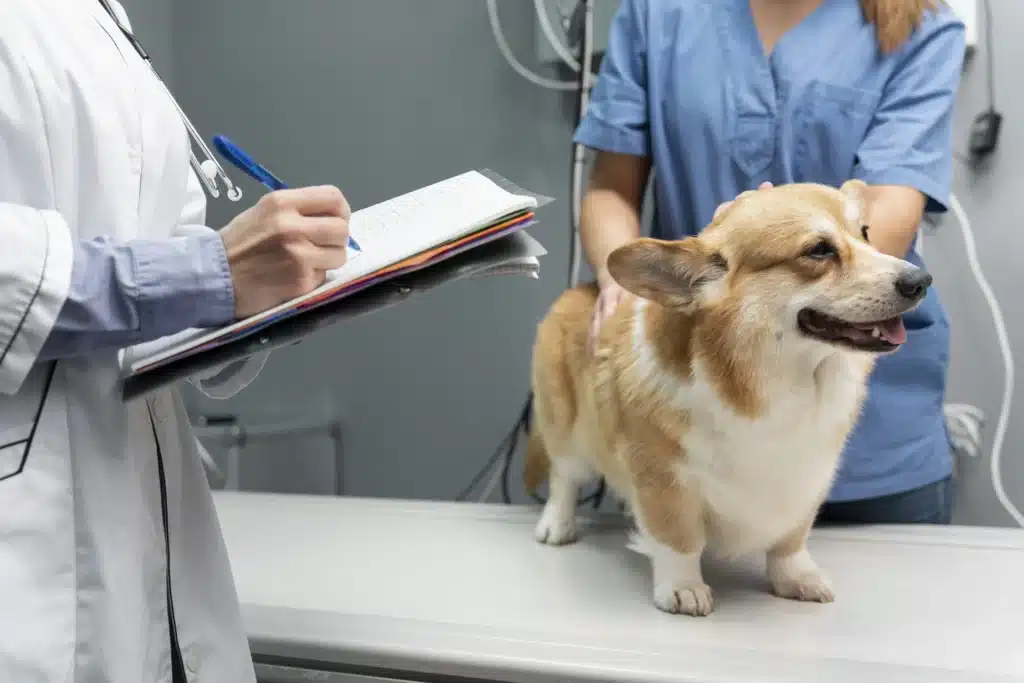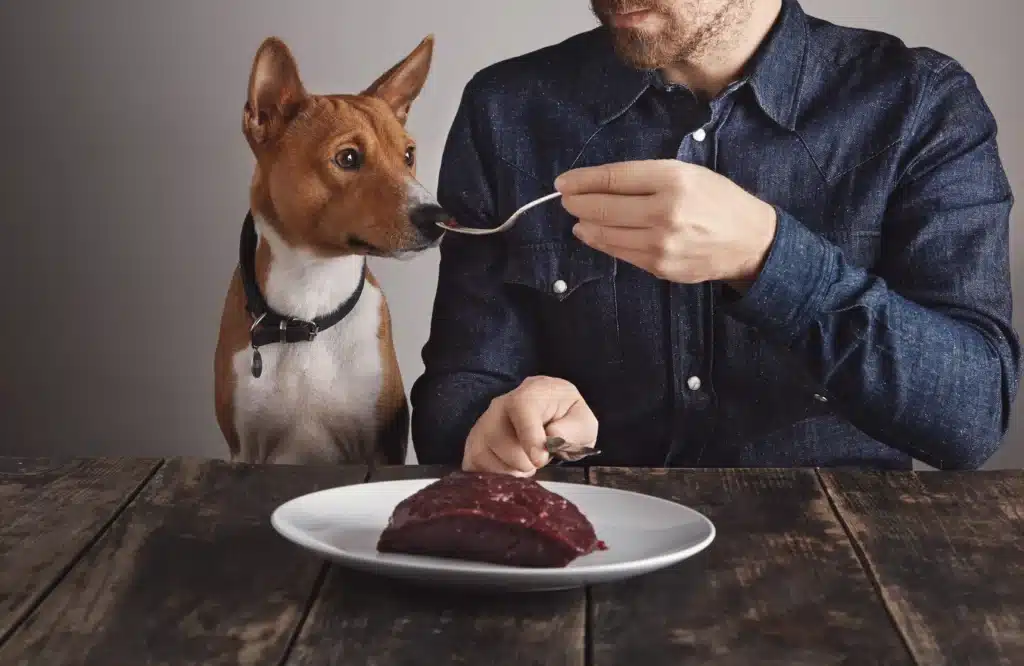Are raw dog food diets a natural, healthy choice or a risky trend? Advocates claim raw diets improve coat shine, digestion, and overall vitality, while critics warn about bacterial contamination, nutritional imbalances, and public health concerns.
Recent studies show that raw meat diets significantly increase the risk of antibiotic-resistant E. coli shedding in dogs compared to non-raw diets (Morgan et al., 2024) and alter gut microbiome diversity. Evidence for changes in metabolism or immune function is less consistent and requires more targeted research. This comprehensive guide covers benefits, risks, costs, supplements, safety protocols, and evidence-based feeding strategies to help you make an informed decision.
Raw Dog Food Diet: Origins and Concept
Raw feeding is not new. Racing greyhounds and sled dogs have long been fed raw meat diets. In 1993, Australian veterinarian Ian Billinghurst introduced the BARF diet — “Bones and Raw Food” or “Biologically Appropriate Raw Food” — suggesting dogs thrive on meals that resemble those of their wild ancestors.
Expert Insight:
Raw feeding is not new. Racing greyhounds and sled dogs are among those whose diets sometimes include raw meat. In 1993, Australian veterinarian Ian Billinghurst introduced the BARF diet — “Bones and Raw Food” or “Biologically Appropriate Raw Food” — arguing dogs thrive on meals resembling those of their wild ancestors. Dr. Lisa Freeman, DVM, PhD, of Tufts University, emphasizes that raw diets may offer benefits, but only if they are nutritionally balanced and handled hygienically.
Raw Dog Food Diet: What It Is
Raw dog food diets — also called RMBDs (Raw Meat-Based Diets) — are feeding plans based on uncooked meat, bones, organs, fruits, and vegetables.
Typical Components
- Muscle meat: Beef, chicken, lamb, or turkey
- Organ meats: Liver, kidney, heart, spleen
- Edible bone: Ground or whole, source of calcium and phosphorus
- Eggs & dairy: Raw eggs, kefir, yogurt
- Vegetables & fruit: Broccoli, spinach, carrots, apples, berries
Owners may choose commercial raw diets (frozen, freeze-dried, or HPP-treated) or homemade recipes (which require supplementation to meet AAFCO standards).
Nutritional Comparison: Raw vs. Kibble
Finding the best dog food for your dog can be tricky with so many choices — kibble, raw, canned, and homemade. Our how to choose the best dog food guide explains what “complete & balanced” means, compares options like raw vs. kibble, and helps you pick the right food for every life stage.
| Nutrient | Raw Diet Typical Range* | Kibble Typical Range* | Comment |
| Protein | ~45-50% (DM) | ~25-35% (DM) | Raw diets are often much richer; they vary by recipe/bones/organs content. |
| Fat | ~40-45% (DM) | ~15-25% (DM) | Raw tends to be high-fat; it requires careful portioning. |
| Calcium: Phosphorus | Varies (often below ideal in homemade raw) | ~1.2:1 (AAFCO target) | Many DIY raw diets fail to meet ideal ratios. |
| Fiber | ~1-3% (DM) | ~3-5% (DM) | Raw often low fiber; kibble includes more plant-derived fiber/carbs. |
*DM = dry matter; ranges are generalizations from recent studies; individual diets may differ significantly.

Research-Backed Benefits
• Improved stool quality & digestion: Dogs fed a raw-meat diet show lower faecal scores (firmer stool) and increased gut bacterial diversity compared to dogs fed extruded kibble.
• Owner-reported skin & coat improvements: In a 2019 survey, many RMBD owners noted shinier coats, cleaner teeth, and enhanced appearance of their dogs.
• Microbiome shifts: Diet transition from processed to raw leads to increased abundance of Fusobacterium and Bacteroidetes, indicating changes toward ancestral-type gut flora. (Xu et al., 2021)
Evidence & Meta-Analysis Review
A 2019 review in Journal of Small Animal Practice found that many raw pet foods exceed hygiene thresholds for Enterobacteriaceae, often carry antibiotic-resistant genes, and that evidence for claimed benefits beyond altered microbiome and improved stool quality remains limited (Davies et al., 2019).
The AVMA policy warns “Raw or Undercooked Animal-Source Protein in Cat and Dog Diets” also warns that raw animal proteins can cause illness in pets and humans, particularly among the very young, elderly, pregnant, or immunocompromised.
Global Guidelines
- According to the WSAVA Global Nutrition Committee, “Home-made RMBDs have a high risk for contamination with bacteria, parasites, and other pathogens… There is currently no properly documented evidence of health benefits for RMBD, but there are well-documented risks.” WSAVA strongly recommends that RMBD not be fed to dogs and cats.
- The AVMA, in its revised “Raw or Undercooked Animal-Source Protein in Cat and Dog Diets” policy, states that apparently healthy pets can have subclinical infections from raw animal proteins, and that methods besides cooking (e.g., heat, pasteurization, or validated kill-steps) may be used to reduce illness risk.
- Per FEDIAF’s “Guide to Good Practice for the Manufacture of Safe Pet Foods,” all member manufacturers must implement HACCP-based controls, monitoring of finished products, environmental sampling, and corrective actions to control pathogens, including Salmonella.
Pros & Cons of Raw Diets
| Pros | Cons |
| Smaller, firmer stools | Pathogen risk to pets & humans |
| Shinier coat & cleaner teeth | Requires strict balancing to avoid deficiencies |
| Supports healthy microbiome | Expensive (2–4× kibble) |
| Fully customizable | Requires freezer space & hygiene discipline |
| May help with food allergies | Not safe for immunocompromised households |
Why Owners Switch to Raw
Case Study:
Maria Lopez switched her German Shepherd to a raw diet after months of chronic GI upset. “Within three weeks, his stools were normal and his coat was glossy,” she says. “My vet helped adjust calcium to make it nutritionally complete.”
Owners often cite distrust of processed kibble, management of allergies, or a belief in “ancestral nutrition.”
Supplementation Needs
Most homemade raw diets require:
- Calcium/Phosphorus: To maintain a 1.2:1 ratio
- Omega-3 fatty acids: For joint and skin health
- Vitamin E & Zinc: Prevent deficiencies common in meat-only diets
- Iodine: For thyroid support

Life-Stage Feeding Guidance
- Puppies: Must meet strict Ca:P ratios to prevent skeletal deformities.
- Working dogs: May need higher fat and calorie content.
- Senior dogs: Benefit from leaner meat, added fiber, and joint supplements.
Cost Breakdown
| Dog Size | Kibble (Monthly) | Commercial Raw (Monthly) | Homemade Raw |
| 10 kg | $25–35 | $60–90 | $50–80 |
| 20 kg | $40–50 | $90–150 | $70–120 |
| 30 kg | $55–70 | $140–200 | $110–170 |
Transitioning Safely
- Start with 25% raw + 75% current food for 2–3 days
- Increase the raw portion every 2–3 days
- Monitor stool consistency and energy
- Always provide fresh water
Storage & Hygiene Checklist
- Freeze meat at −18 °C until ready
- Thaw in refrigerator, never at room temperature
- Disinfect surfaces with 1:10 bleach solution
- Wash bowls after every meal
- Discard leftovers after 30 minutes

Signs of Nutritional Imbalance
- Dull coat or hair loss
- Limping or bone pain
- Weight loss or gain
- Chronic diarrhea or constipation
If symptoms appear, consult your vet and consider a diet review.
Veterinary Recommendations
- Choose HPP-treated or pathogen-tested diets (Lee et al., 2023).
- Use board-certified veterinary nutritionist recipes for homemade plans.
- Follow strict hygiene protocols (FDA, 2023).
- Schedule biannual bloodwork to check calcium, phosphorus, vitamin D, and organ function.

Public Health Data & Zoonotic Risk
- The CDC explicitly states: “Pet food and treats can sometimes be contaminated with germs that make people and animals sick. The CDC does not recommend feeding raw pet food or treats to dogs and cats.” Vulnerable persons (children under 5, older adults, pregnant people, and immunocompromised individuals) are especially at risk.
- The FDA conducted a study of 196 raw pet food samples; results showed 15 of those were positive for Salmonella, and 32 were positive for Listeria monocytogenes. The study concluded that raw pet food poses a public health risk both to animals eating it and the people handling it.
Frequently Asked Questions
Can you mix kibble and raw?
Yes, but transition gradually. Some dogs do better with separate meals.
Can dogs eat raw eggs?
Yes, if fresh and pathogen-free. Wash hands after handling.
How much raw food should I feed?
Generally 2–3% of body weight per day, divided into two meals.
Is freeze-dried raw safer?
Freeze-drying reduces but does not completely eliminate pathogens — buy from a reputable brand.
Bottom Line
Raw dog food diets can improve stool quality, coat health, and microbiome diversity — but they also carry risks of bacterial contamination, nutrient imbalance, and public health concerns.
If you choose raw feeding:
- Select pathogen-tested or HPP-treated diets
- Balance nutrients with supplements or professional recipes
- Transition gradually and monitor health
- Follow strict storage and cleaning protocols
When done responsibly, raw feeding can support a healthy lifestyle for some dogs. Without veterinary guidance, the risks may outweigh the benefits — especially for puppies and immunocompromised pets.
References
- Anturaniemi, J., et al. (2020). Raw diet and serum vitamin D levels in dogs. British Journal of Nutrition.
- Baum, H., et al. (2024). Reasons for discontinuation of raw meat diets in dogs. Journal of Animal Nutrition.
- Cai, X., et al. (2022). Food processing effects on digestibility, fecal microbiota, and SCFAs in adult beagles. PLOS ONE, 17(3):e0262284.
- Davies, R., et al. (2019). Antimicrobial-resistant E. coli in raw pet food diets. Veterinary Record.
- Dillitzer, N., et al. (2011). Nutritional adequacy of home-prepared raw diets for dogs. Journal of Animal Physiology and Animal Nutrition, 95(1), 90–97.
- EFSA (2023). Public health risk assessment of raw meat-based diets for cats and dogs. European Food Safety Authority.
- Freeman, L. M., et al. (2013). Nutritional risks of raw meat-based diets. JAVMA, 243(11), 1549–1558.
- Lee, S., et al. (2023). Inactivation of Salmonella, STEC, and Listeria in raw pet food using HPP. Food Microbiology.
- Lenz, J., et al. (2009). Risks of feeding bones to dogs. Journal of Small Animal Practice, 50(10), 519–522.
- Morgan, G., et al. (2024). Raw meat diets increase multidrug-resistant E. coli shedding. Frontiers in Microbiology.
- Sandri, M., et al. (2017). Microbiome and fecal characteristics in dogs fed raw diets. PLOS ONE, 12(1):e0170632.
- van Bree, F., et al. (2018). Zoonotic bacteria in raw meat-based diets for pets. Veterinary Record, 182, 50.
- Xu, J., et al. (2021). Gut microbiota changes in dogs fed raw diets. Frontiers in Microbiology, 12:701439.


